Overview
Securing financial assistance for autism can feel overwhelming, but there are various avenues available, including:
- Government programs
- Grants
- Community resources
These options are specifically designed to support families with children on the spectrum. It's essential to conduct thorough research, gather proper documentation, and engage with your community to effectively access these resources. By doing so, you can significantly enhance the quality of life for your family. Remember, you are not alone in this journey; many families share similar experiences and challenges. Together, we can navigate these options and find the support you need.
Introduction
Navigating the financial landscape for families with children on the autism spectrum can feel overwhelming. However, understanding the available assistance options is crucial for securing the vital support your family needs.
From government programs like Supplemental Security Income (SSI) and Medicaid to private grants and community resources, there are various avenues to help alleviate the financial burden associated with autism care. Each state offers unique programs tailored to meet the specific needs of families, while federal initiatives provide additional layers of support.
This article will delve into the diverse financial assistance options available, explore effective financial planning strategies, and highlight the importance of building a robust support network. Together, we can empower families to access the resources necessary for their child's well-being and development.
Understanding Financial Assistance Options for Autism
Navigating financial aid, including autism financial assistance, can be a daunting journey for families with developmental disorders. Understanding the various options available is crucial for securing the support needed. The primary categories of monetary aid include:
- Government Programs: Families can access vital programs such as Supplemental Security Income (SSI), Medicaid, and state-specific initiatives designed to support children diagnosed with developmental disorders. These programs are essential, providing necessary economic relief to households facing the challenges of autism financial assistance. Research indicates that many families rely on government support for autism-related expenses, particularly in demographic groups with higher identification rates. For instance, in 2020, the percentage of 8-year-old Asian or Pacific Islander, Hispanic, and Black children identified with ASD was notably higher than that of their White counterparts, highlighting the urgent need for targeted financial assistance.
- Grants: Numerous organizations also offer grants specifically aimed at providing autism financial assistance for related expenses. These grants can help cover costs for therapy, educational needs, and other essential services, alleviating some of the financial burdens families experience. Success stories of families utilizing private grants for autism financial assistance underscore the significant impact these resources can have. Data from the U.S. Department of Education (2018-2019) reveals that 74% of autistic students in the U.S. graduate with a diploma, compared to 86% of all students, illustrating the critical role financial aid plays in achieving educational success.
- Community Resources: Community resources, such as local nonprofits and community action agencies, often provide autism financial assistance or can guide families to available resources. These organizations are instrumental in connecting families with the support they need. However, many families receiving government assistance face challenges in accessing the full range of services available. As noted by Durkin et al., low-income children with ASD may be underidentified and less likely to receive necessary services compared to their higher-income peers.
- CDC Monitoring: Additionally, the CDC has been actively monitoring ASD since 1996, aiming to provide essential data and develop resources for early identification. By thoroughly exploring and leveraging these autism financial assistance options, parents can find the best avenues for support tailored to their child's unique needs.

State-Specific Programs and Resources for Autism Support
Every state provides a variety of initiatives and resources designed to offer financial assistance for autism to families with children on the spectrum. Consider some key examples:
- State Medicaid Waivers: Many states have introduced Medicaid waivers that allocate funding specifically for autism financial assistance, which encompasses vital therapies and support services. These waivers are crucial, as they enable families to access necessary interventions and financial aid that can greatly improve outcomes for their children.
In fact, a substantial number of families benefit from these waivers, with many autistic youth in the U.S. starting vocational rehabilitation services during high school, underscoring the significance of early intervention. Notably, California alone has reported a total of 564,024 ASD cases, emphasizing the urgent need for effective state-specific resources.
Local nonprofits, such as the Autism Society, operate chapters that provide autism financial assistance, resources, and support groups tailored to meet the needs of families. These organizations play a vital role in connecting families with community resources and offering emotional support. It is important to recognize that racial and ethnic disparities have been observed over the years in ADDM data, which can affect access to these essential resources.
- State Education Programs: Several states offer autism financial assistance that includes funding for Individualized Education Programs (IEPs), helping to cover costs associated with special education services. These programs are key to ensuring that children receive the personalized educational support they require to thrive. Additionally, understanding the gender disparities in ASD diagnosis can help families navigate the unique challenges they may face, as highlighted in recent research that points to the need for improved diagnostic practices.
- Crisis Assistance: For families in crisis, the 988 Lifeline offers 24/7 free and confidential support and crisis resources, establishing a crucial safety net for those managing the complexities of autism financial assistance.
To discover specific programs available in your state, we encourage you to visit your state’s health department website or reach out to local advocacy organizations focused on developmental disorders. By utilizing these resources, families can more effectively navigate the complexities of assistance for individuals on the spectrum.
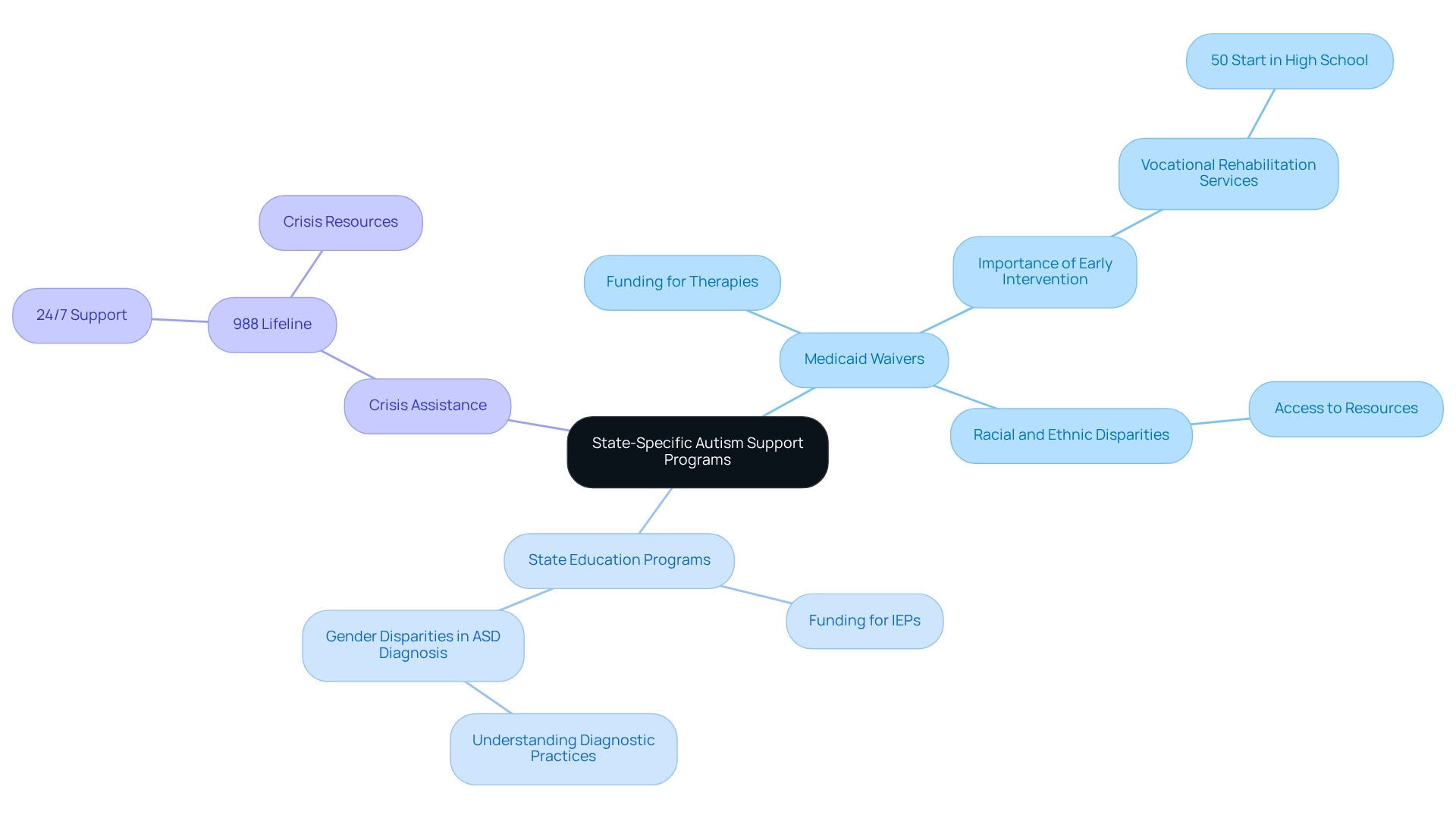
Navigating Federal Financial Assistance Programs
Navigating the world of financial assistance can be overwhelming, especially for families with children diagnosed with autism. National monetary aid initiatives are here to provide vital support, offering a lifeline to households in need. Key programs that can make a significant difference include:
- Supplemental Security Income (SSI): This program offers monthly payments to low-income individuals with disabilities, including children with autism. Eligibility is based on income and resources, ensuring that families receive the help they need.
- Social Security Disability Insurance (SSDI): For households where a parent has a disability, SSDI can provide essential benefits that support the family financially during challenging times.
- Medicaid: This program ensures health coverage for eligible low-income individuals, offering autism financial assistance for related therapies and services.
To effectively navigate these programs, families should gather necessary documentation, such as medical records and proof of income. It's also beneficial to consult the Social Security Administration's website for detailed application instructions. Remember, you are not alone in this journey, and there are resources available to help you every step of the way.
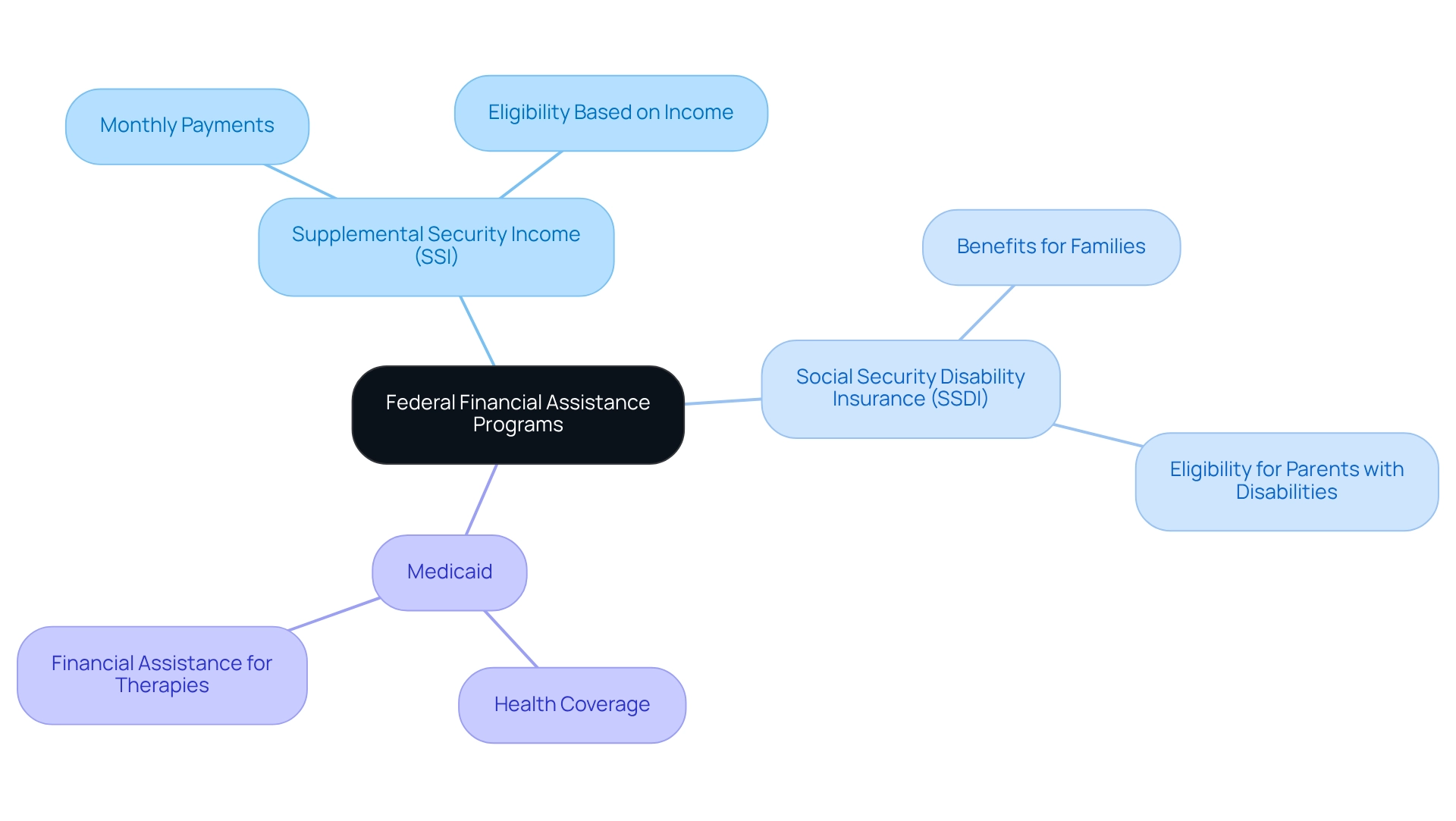
Exploring Scholarships and Grants for Autism-Related Expenses
Scholarships and grants can provide essential relief for families facing the financial challenges associated with autism-related expenses. Understanding the weight of these burdens, here are some supportive options to consider:
- Educational Scholarships: Numerous organizations offer scholarships tailored for students with autism, aimed at alleviating tuition and educational material costs. Notable examples include the Microsoft Disability Scholarship and the Autism Can Do Scholarship.
- Therapy Grants: Organizations like Autism Care Today extend financial assistance to households, specifically to support therapy expenses. Typically, applications require proof of diagnosis and a demonstrated need for assistance.
- Local Community Grants: Reach out to local advocacy organizations to explore funding opportunities that may be available to families in your area.
When applying for these scholarships and grants, it’s vital for families to prepare a comprehensive application. This should clearly outline their child’s needs and the economic impact that developmental disorders have on their household. Sharing your story not only highlights the importance of support but also encourages others to seek the help they deserve.
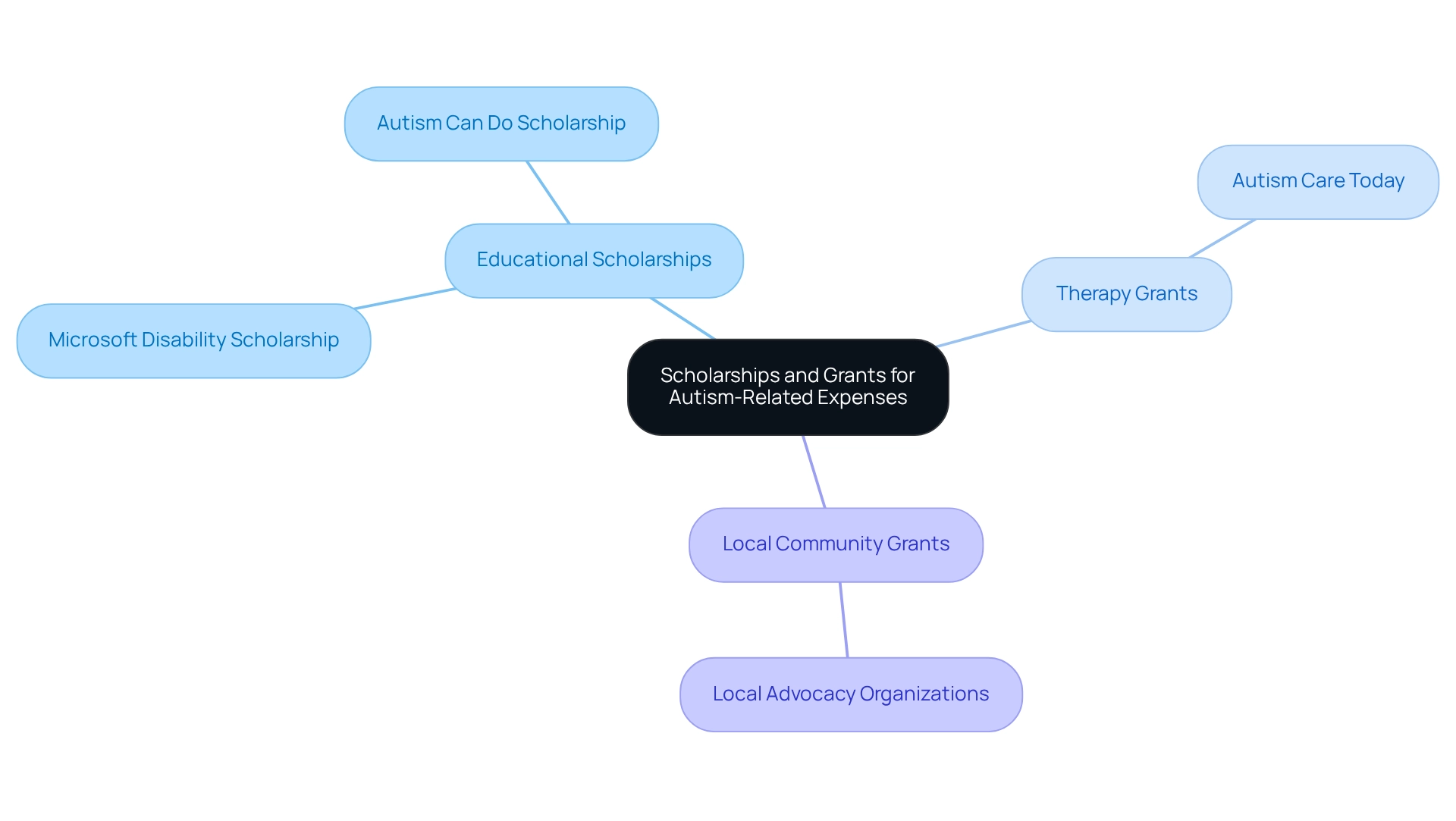
Financial Planning Strategies for Families with Autism
Efficient budgeting is essential for families with children on the spectrum to secure autism financial assistance, as it can significantly influence their quality of life and the availability of necessary services. Here are several strategies to consider:
- Create a Comprehensive Budget: Start by outlining all monthly expenses, including therapy, medical care, and educational costs. This approach provides a clearer picture of your financial landscape and helps identify areas for adjustments. In 2018, mean expenditures for children with autism in Medicaid claims data ranged from $11,000 to $30,000, underscoring the importance of thorough budgeting. A study utilizing Medical Expenditure Panel Survey (MEPS) data linked to National Health Interview Survey (NHIS) data offers new estimates of healthcare costs for children with ASD, highlighting the necessity for caregivers to be well-informed about these expenses.
- Establish a Special Needs Trust: Setting up a special needs trust can be a crucial step in managing your child's assets without jeopardizing their eligibility for government benefits. This legal arrangement allows families to provide for their child's needs while ensuring they continue to receive essential support.
- Explore Tax Benefits: Families may qualify for various tax deductions related to medical expenses and special education costs. Consulting with a tax expert can help maximize these advantages, potentially alleviating the economic burden associated with autism care.
- Plan for the Future: It is vital to consider long-term care needs and potential future expenses. Beginning to save early can ensure economic security and peace of mind. For instance, a recent analysis indicated that insurance type significantly influences healthcare costs, with Medicaid expenditures consistently higher than those of private insurance by at least $15,000. This highlights the necessity for households to plan strategically based on their insurance coverage. As Lindsay Lawyer from the Department of Psychiatry at the University of Pennsylvania observes, "Efficient budget planning is crucial for households managing the intricacies of developmental disorder support."
By proactively managing finances and implementing these strategies, families can alleviate some of the stress associated with funding care for those with developmental disorders, including the pursuit of autism financial assistance. Ultimately, this approach enhances their child's quality of life and access to essential services. These initiatives align with ASD Media's objective of promoting cooperation and development in the ABA therapy sector, ensuring that families obtain the support they need in their planning endeavors.
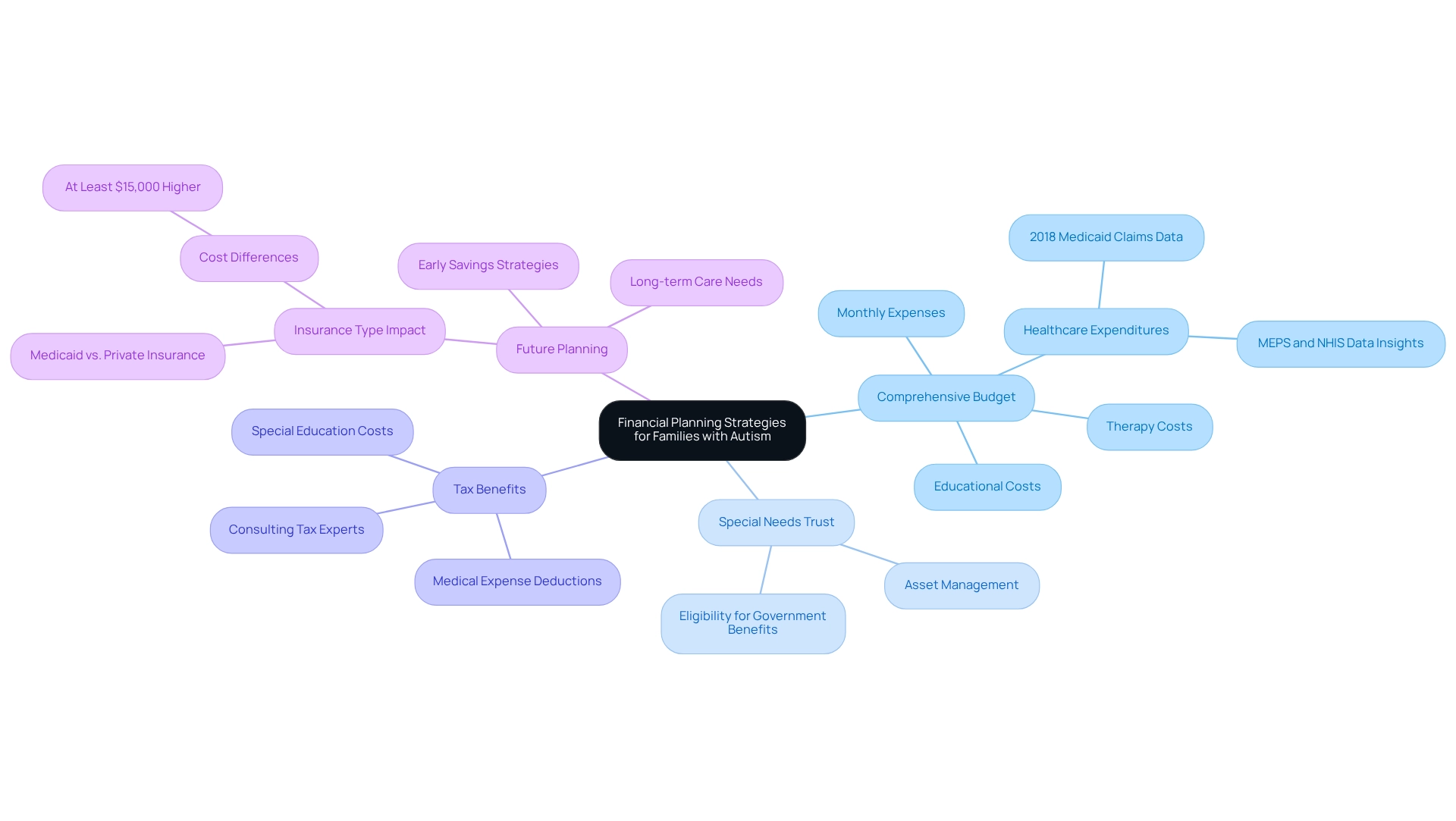
Managing Medical Debt and Financial Challenges
Managing medical debt can feel overwhelming for families with children diagnosed with autism, making autism financial assistance essential. As Dena Gassner, an adjunct professor at Towson University, poignantly observes, "We come to the systems, like Social Security or to a social service agency, often in our darkest moments." This statement underscores the emotional journey many families face when seeking monetary support.
Yet, there are effective strategies that can help lighten this financial load:
- Negotiate Medical Bills: Don't hesitate to reach out to healthcare providers to discuss potential payment plans or negotiate lower rates based on your financial situation. Many households have successfully reduced their expenses through open communication and persistence.
- Seek Aid Programs: Numerous hospitals and clinics offer assistance programs specifically tailored for families in need. It’s vital to inquire about autism financial assistance options at the time of care, as these can significantly alleviate financial pressures.
- Utilize Community Resources: Local nonprofits often provide support with medical expenses or can connect families to additional resources aimed at managing debt. Engaging with these organizations can unlock valuable support networks.
- Consider Medical Debt Forgiveness Programs: Some organizations focus on helping families reduce or eliminate medical debt. Exploring these options can reveal opportunities for financial assistance that may not be widely known.
In fact, approximately 4.1 million disabled individuals receive vital nutrition assistance through programs like SNAP, highlighting the importance of support systems for families facing medical expenses. Furthermore, statistics indicate that a significant number of households discuss medical expenses related to developmental care, demonstrating that proactive involvement can lead to positive outcomes. Additionally, scholarships are available specifically for students with developmental disorders to help cover college expenses, providing further resources for families considering long-term educational costs.
By implementing these proactive measures, families can alleviate some of the economic pressures associated with caring for individuals on the spectrum and may access autism financial assistance, allowing them to focus more on their child's health. Moreover, understanding the duration of incapacity approval can help families maintain coverage for their children, illustrating the importance of effectively navigating medical debt and insurance challenges. Finally, exploring ABLE accounts can offer crucial resources for families managing financial difficulties linked to autism financial assistance for individuals with disabilities.
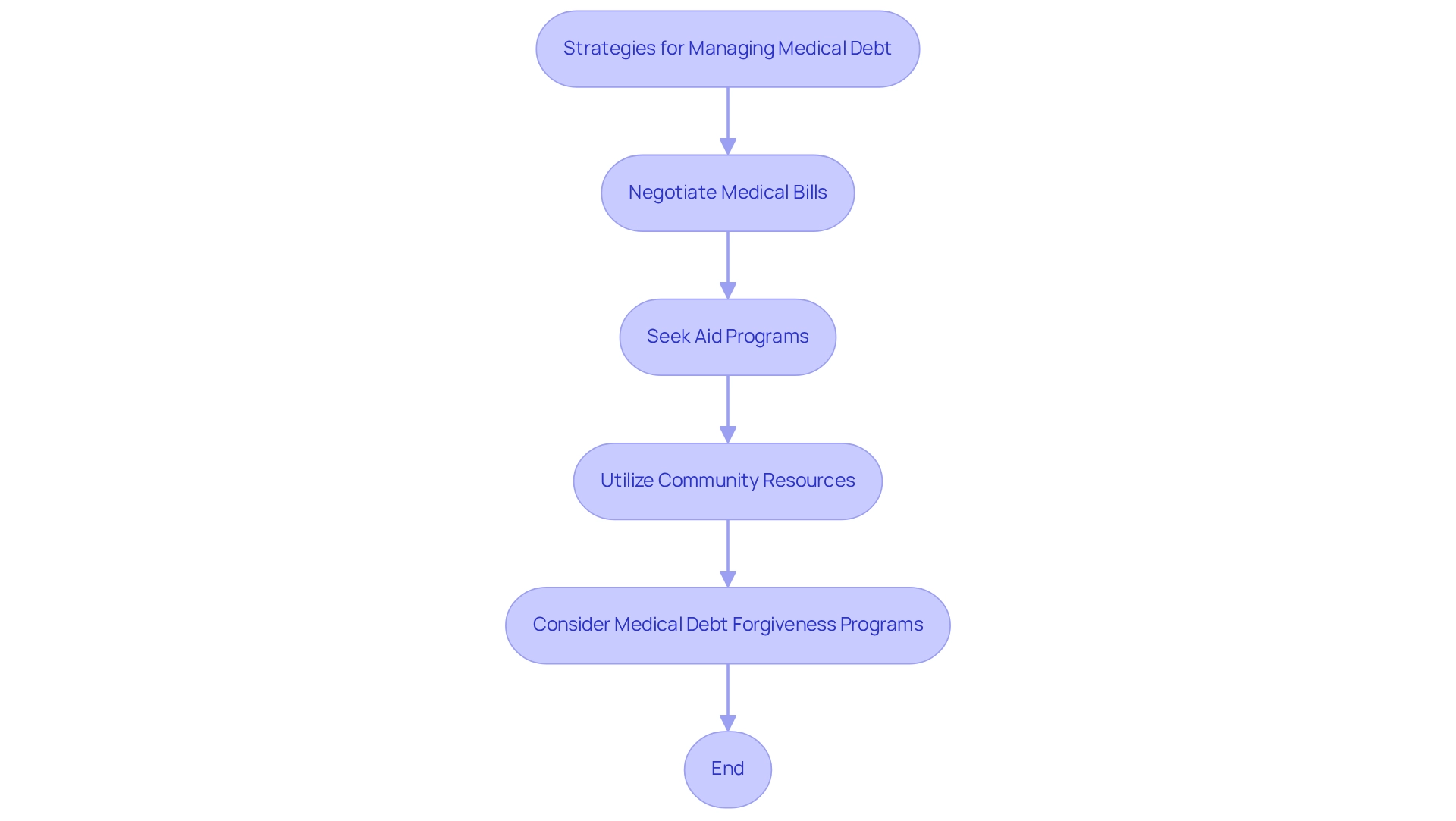
Building a Support Network: Community Resources for Parents
Creating a strong network for autism financial assistance is essential for parents of children with developmental disorders. It can feel overwhelming at times, but there are effective strategies to connect with community resources that can make a significant difference.
- Join Local Support Groups: Many communities offer support groups specifically for parents of children with autism. These groups provide a welcoming environment where you can share experiences, seek advice, and foster connections with others who understand the unique challenges of obtaining autism financial assistance.
- Engage with Local Autism Organizations: Organizations such as the Autism Society frequently organize events, workshops, and provide valuable resources tailored for families. By interacting with these organizations, you can gain new information and support related to autism financial assistance.
- Utilize Online Communities: Online forums and social media groups serve as additional platforms for assistance, allowing parents to connect with others who are navigating similar challenges. These virtual spaces can be invaluable for sharing insights and strategies, creating a sense of belonging.
- Attend Workshops and Seminars: Look for local workshops that focus on education related to developmental disorders, financial planning, and coping strategies. These events not only provide knowledge but also create opportunities to meet other parents and professionals in the field.
By actively seeking these community resources and autism financial assistance, parents can develop a robust network that significantly enhances their ability to care for their child. For instance, a case study titled "Strategies for Supporting Individuals with Autism" highlights how establishing routines and using visual aids can create stability and comfort, promoting independence and reducing anxiety. This approach underscores the importance of collaboration and shared experiences among parents, reinforcing the idea that, as Harvey C. Jenkins wisely stated, "It is OK to be different."
With around 1 in 44 children identified with the condition, the demand for effective support networks is more urgent than ever. This statistic highlights the necessity for parents to engage with resources related to autism financial assistance, making these connections essential for families aiming to navigate the complexities of the condition together. ASD Media is committed to fostering collaboration and growth in the ABA therapy industry, further supporting parents and professionals in their journey.

Actionable Steps to Secure Financial Assistance for Autism
Securing financial assistance for autism can feel overwhelming, but by following these actionable steps, parents can significantly improve their chances of success:
- Research Available Resources: Start by identifying a variety of local, state, and federal programs that offer financial assistance for autism-related expenses. This includes grants, scholarships, and government aid designed to support families. It's worth noting that 595 entries have been identified that meet the criteria for age and inclusion of technology and media, highlighting how crucial thorough research is in uncovering available resources.
- Gather Necessary Documentation: Take the time to compile all required documents carefully. This should include medical records, proof of income, and any other relevant information needed for your applications. Proper documentation is vital, as it can greatly influence the approval process. As Vince Waite, MD, emphasizes, "Client readiness is imperative to successful engagement," underscoring the importance of being well-prepared.
- Apply for Assistance: Complete applications for the identified programs, ensuring that all information is accurate and comprehensive. Statistics reveal that well-prepared applications tend to have a higher success rate, with many families reporting positive outcomes when they clearly articulate their needs.
- Follow Up: After submitting your applications, it’s essential to follow up with the respective agencies or organizations. This proactive approach can keep you informed about your application status and help you address any potential issues quickly.
- Connect with Assistance Networks: Engage with local autism organizations and support groups. These networks can provide invaluable support, share resources, and connect you with families who have successfully navigated the assistance landscape. For instance, the Community Foundation facilitates the awarding of over £100 million in grants to individuals and local communities, inspiring generosity and fostering impactful change.
By implementing these steps, parents can more effectively navigate the landscape of autism financial assistance, increasing their chances of securing the necessary support for their children. Case studies indicate that families who actively engage with community resources and follow structured application processes often achieve better outcomes, securing vital funding to enhance their children's quality of life. Additionally, it is essential to consider the ethical implications of researching children's digital interactions, as informed consent plays a crucial role in navigating the complexities of financial assistance.
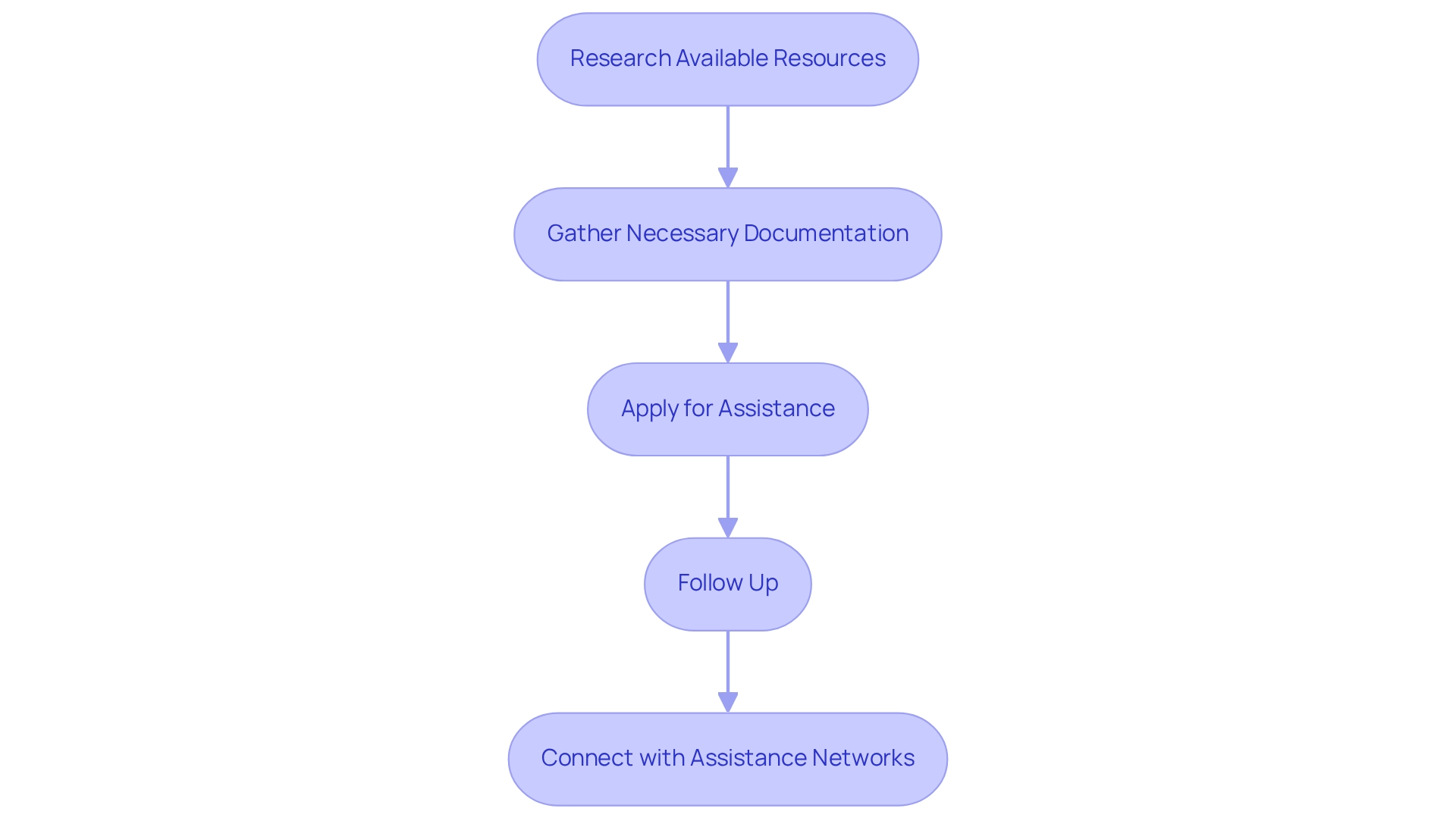
Conclusion
Navigating the financial landscape for families with children on the autism spectrum can feel overwhelming. It's crucial to understand the available resources and strategies to ease this journey. This article highlights various financial assistance options, including essential government programs like Supplemental Security Income (SSI) and Medicaid, which many families rely on to manage the costs associated with autism care. Additionally, private grants and community resources provide critical support, helping to alleviate financial burdens that can weigh heavily on families.
State-specific programs further enhance the support available, offering tailored solutions that meet local needs. Educational scholarships and therapy grants play a vital role in improving outcomes, ensuring that children receive the necessary services for their development. By employing effective financial planning strategies—such as creating a comprehensive budget and establishing special needs trusts—families can take proactive steps to manage their finances and secure their future.
Building a strong support network is equally important. Connecting with local organizations, attending workshops, and engaging with online communities allows parents to share experiences and access valuable resources that can ease their journey. The actionable steps outlined in this article serve as a roadmap for families seeking financial assistance, emphasizing the importance of thorough research, proper documentation, and persistent follow-up.
Ultimately, understanding and leveraging these financial assistance options can significantly improve the quality of life for families with children on the autism spectrum. By taking advantage of available resources and fostering community connections, families can navigate the complexities of autism care with greater confidence and support. Together, we can create a brighter future for our children.
Frequently Asked Questions
What types of financial aid are available for families with children diagnosed with autism?
Families can access several types of financial aid, including government programs (like Supplemental Security Income and Medicaid), grants from various organizations, community resources, and monitoring efforts by the CDC.
How do government programs assist families with autism financial needs?
Government programs provide essential support such as Supplemental Security Income (SSI) and Medicaid, which help alleviate economic burdens related to autism-related expenses.
What role do grants play in autism financial assistance?
Grants offered by various organizations help cover costs for therapy, educational needs, and other essential services, significantly reducing the financial strain on families.
How do community resources contribute to autism financial assistance?
Local nonprofits and community action agencies provide autism financial assistance and guide families to available resources, helping them connect with necessary support.
What challenges do families face when accessing financial assistance for autism?
Many families receiving government assistance face difficulties in accessing a full range of services, and low-income children with ASD may be underidentified and less likely to receive necessary support compared to their higher-income peers.
What specific state initiatives are available for autism financial assistance?
States offer initiatives such as Medicaid waivers for funding therapies and support services, state education programs for Individualized Education Programs (IEPs), and crisis assistance through resources like the 988 Lifeline.
How does the CDC contribute to autism financial assistance?
The CDC monitors autism spectrum disorder (ASD) and provides data and resources for early identification, which can help families find appropriate support.
Where can families find information about specific programs available in their state?
Families can visit their state’s health department website or contact local advocacy organizations focused on developmental disorders to discover available programs and resources.




